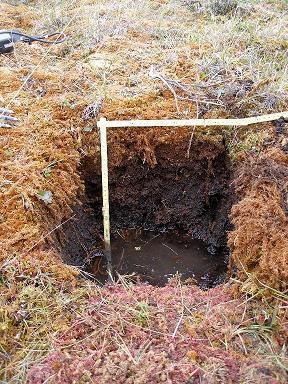(Upload on February 10 2013) [ 日本語 | English ]
Mount Usu / Sarobetsu post-mined peatland
From left: Crater basin in 1986 and 2006. Cottongrass / Daylily
HOME > Lecture catalog / Research summary > Wetland research > Wetlnad > Peat
[ peat | utilization ( 利用 )| references ]

Sometimes called turf (also called peat soil (泥炭土) in soil science )
The accumulation and decomposition of peat are greatly reated to global warming because of large carbon sinks
Partially-decayed plant matter that is accumulated mostly in boreal wetlands (湿原), such as in
tundra (ツンドラ), when the accumulation of plant matter is faster than the decomposition.
One of the characteristics of peat in Hokkaido is that the peat often contains tephra (テフラ).
= von Post (humification) scale (フォンポスト腐植化尺度) assessing peat decomposition
The decomposition of peat is greatly related to global warming, because of carbon emission
| Degree of decomposition | Nature of squeezed liquid | Proportion of peat extruded | Nature of plant residues | Description |
| H1 | Clear, colourless | None | Plant structure unaltered Fibrous, elastic | Undecomposed |
| H2 | Almost clear, yellow-brown | None | Plant structure distinct, almost unaltered | Almost undecomposed |
| H3 | Slightly turbid, brown | None | Plant structures distinct, most remains easily identifiable | Very weakly decomposed |
| H4 | Strongly turbid, brown | None | Plant structure distinct, most remains identifiable | Weakly decomposed |
| H5 | Strongly turbid, contains a little peat in suspension | Very little | Plant structure clear but indistinct and difficult to identify | Moderately decomposed |
| H6 | Muddy, much peat in suspension | One third | Plant structure indistinct but clearer in residue, most remains undefinable | Well decomposed |
| H7 | Strongly muddy | One half | Plant structure indistinct | Strongly decomposed |
| H8 | Thick mud, little free water | Two thirds | Plant structure very indistinct - only resistant material such as roots | Very strongly decomposed |
| H9 | No free water | Nearly all | Plant structure almost unrecognisable | Almost completely decomposed |
| H10 | No free water | All | Plant structure not recognisable, amorphous | Completely decomposed |
H1 = no decomposition ↔ H10 = complete decomposition
Chemical property |
Physical property |
| Kind of organic materials | Fibre content | Sodium pyrophosphate extract color | |
| unrubbed | rubbed | ||
| Sapric (saprist soil) | > 1/3 < 1/3 | < 1/6 | 6/3, 5/2, 4/1, 3/1, 2/1 or darker outside range of fibric or sapric material |
| Hemic (fibrist soil) | 1/3 to 2/3 > 2/3 | > 1/6 < 2/5 & 3/4 | 7/1, 7/2, 8/1, 8/2, 8/3 |
|
Land covered with peat = muskeg, moor, organic terrein Soil saturation (土壌飽和): pores in soil completely filled with water Soil drainage classes: describe file soil moisture conditions as determined by the capacity of the soil and the site for removing excess water. The classes range from very well drained, where excess water is removed very, quickly, to very poorly drained, where excess water is removed very slowly. Wetlands include all soils in the very poorly drained and poorly drained classes, and some soils in the somewhat poorly drained class |
Temporarily wet soil (一時的湿性土壌): the soil close to the soil surface (i.e. within 40 cm) is occasionally wet for periods > 2 weeks during the wet season in most years. However, it is seldom flooded or saturated at the surface for longer than a month.
Use (利益)containing 400 billion tons of carbon and cut down the amount of greenhouse gasesharvested, dried, and used as a fuel harvested for use as a soil conditioner and plant packing material |